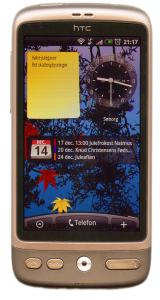OK, so you’ve bought yourself an Android phone. Smart move. Your new high-tech marvel will not just keep track of your Facebook friends, show videos from YouTube and track your running on Endomondo – it can actually be used for phone-calls too.
But the argument you used to justify the purchase for yourself, was the fact that such a smartphone would be a great help in your daily work, giving you direct access to your e-mail, calendar, etc.
And it will. If your e-mail is Gmail, your calendar is Google Calendar, etc., then everything will sync right out of the box once you’ve logged into your Google account from your Android. But if you have another provider of e-mail, it takes a little more planning.
Here is my experience, based on the following scenario: At work I use MS Outlook to manage my calendar and my work e-mail. This is done through my workplace Exchange server. On my home PC and my personal laptop I also use Outlook, which retrieves private e-mail via my web provider.
The aim is to have my data synchronized between the different platforms automatically and invisibly. The strategy is to create a Google account, and then use it as a hub. Here are a few tips on how:
Calendar
My Google Calendar is the mother ship. My Android phone has a calendar that automatically synchronizes with my Google calendar. The trick then is to have Google calendar sync with Outlook on the PCs I use. It can be done using the Google Calendar Sync. It’s a nifty little Outlook extension that can be downloaded free, and automatically synchronizes the contents of an Outlook calendar with Google Calendar.
Unfortunately, Calendar sync has some limitations. I use Outlook’s categorization feature to distinguish between private and work-related appointments. In Google calendar I can do the same, but in a slightly different way: I have to create separate calendars for different categories of appointments. And Google Calendar Sync can only handle one calendar.
Consequently, I purchased gSyncit. It will cost you $ 20 per. installation. In return it offers a plethora of settings to fine tune synchronizations. So many that it can be confusing at first. But after tampering with it for a little while, I can now rejoice at having the exact same calendar on my work PC, my home PC, my laptop and my Android phone.
If you are not satisfied with the calendar on your Android, there are alternatives such as Jorte. However, I have chosen to use the built-in calendar – but I have added Smooth Calendar, a widget that is slightly more useful than the built-in.
E-mail
In principle, my Android will connect to the Exchange server at my workplace without any problems. Unfortunately, our IT department is very sceptic about anything not made in Redmond, and equipped with Bill Gates personal digital signature. So, for the time being, I have given up direct access to my work e-mail, and settled for web access. But my private e-mail works fine.
 I have set up the e-mail program on my Android to use Imap. In contrast to the classical POP3, Imap is a client-server protocol. The effect of that is that everything you do with your e-mail is directly reflected on the mail server. If, for example, you read a few mails and send a response from Android, it will be indicated which mails have already been read, when you later open Outlook on your PC, and the reply sent from Android will be placed in Outlook’s “Sent Items” folder, etc.
I have set up the e-mail program on my Android to use Imap. In contrast to the classical POP3, Imap is a client-server protocol. The effect of that is that everything you do with your e-mail is directly reflected on the mail server. If, for example, you read a few mails and send a response from Android, it will be indicated which mails have already been read, when you later open Outlook on your PC, and the reply sent from Android will be placed in Outlook’s “Sent Items” folder, etc.
Or rather: this is how it should be. Sadly, Android’s built-in e-mail program can not figure out how to put sent mail in the correct folder on the server. For this, and other reasons, it is worth replacing it with K-9, an alternate e-mail client which can be downloaded free from Android Market. Unfortunately, problems do not stop here: Outlook too does not support Imap 100%. You will experience small irritations, such as sent items that end up in the wrong folders.
No doubt that Imap is a smart technology. And when Google and Microsoft get their acts together, we will all be happy….
Task Lists
gSyncit will also synchronize your task list(s) in Outlook with Google tasks. gTask, downloadable from Android market, will then synchronize your Google tasks to and from your Android. You can set up gTask to display a widget in the shape of a yellow “post it” note, which will automatically displays your tasks.
That’s all for now. For perfectionists, there are of course several additional possibilities, such as synchronizing contacts, notes, files, password, etc. But that will have to wait for another day….
Ja, android sparker så meget mere r… end phone! Tak for et godt indlæg!